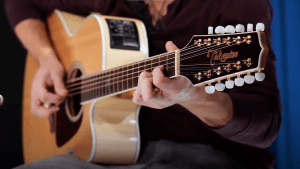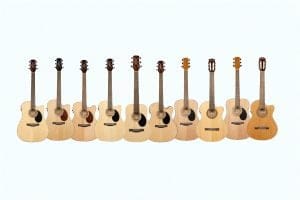Table of Contents
Headstocks not only hold and anchor the strings but also allow for adjusting their tension for proper tuning. Classical guitar headstocks come in various designs, each with its own unique characteristics and aesthetic appeal.
Let’s explore the different types.
Are you a newbie and looking for your first classical guitar? Check out our list of best classical guitars for beginners; you might find your perfect one!
Slotted Headstock: A Timeless Elegance
The slotted headstock is a traditional design that features curved or angled slots instead of enclosed holes for the nylon strings. This style is commonly found in classical guitars made in Spanish guitars and flamenco guitars. Slotted headstocks offer a distinct, elegant look and are cherished for their rich history.
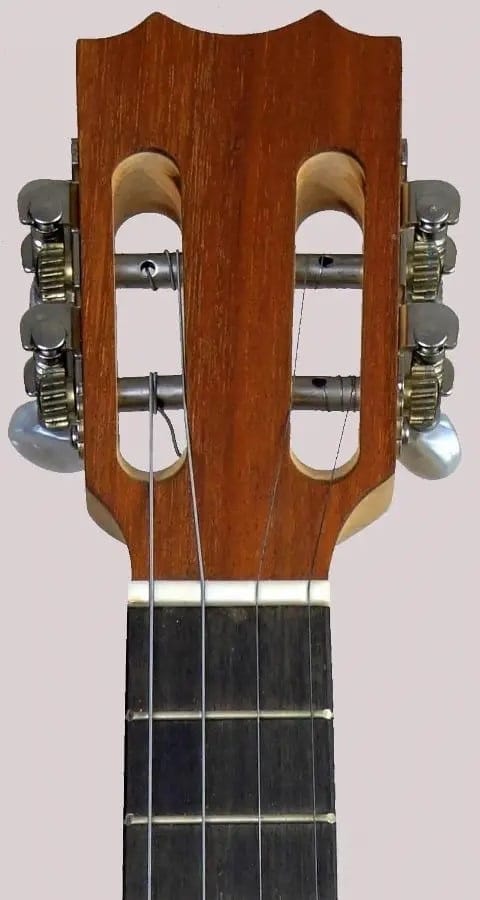
Volute: Artistic Flourish
A volute is a decorative scroll-like feature often found at the base of the headstock, where it meets the guitar neck. While primarily serving as an aesthetic element, a volute can also reinforce the joint between the headstock and the neck, providing additional strength and stability.
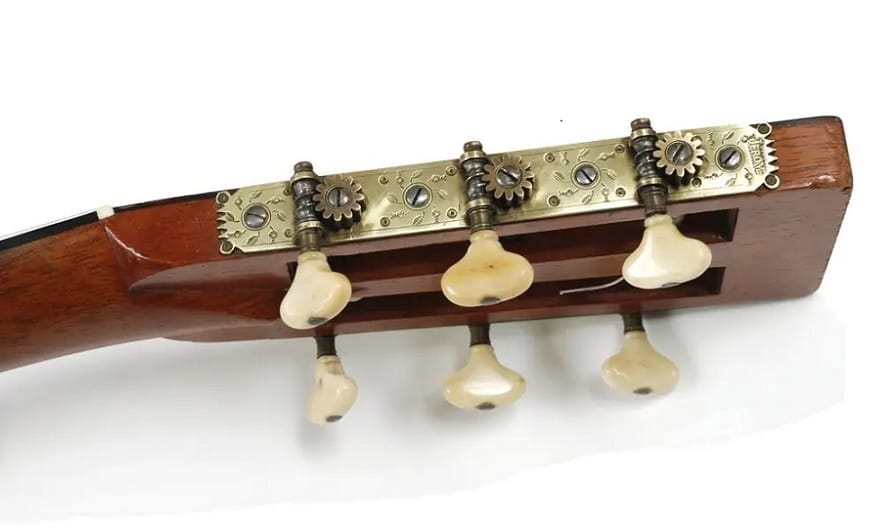
When it comes to classical guitar brands known for their high-quality headstocks, there are several notable names in the industry. Here are five brands that are recognized for their exceptional craftsmanship and headstock designs, along with an explanation of what sets their headstocks apart:
Top Classical Guitar Headstock Brands
When it comes to classical guitar brands known for their high-quality headstocks, there are several notable names in the industry. After recharging market reviews and gathering personal experiences, we have finally made a list. So, here are five brands that are recognized for their exceptional craftsmanship and headstock designs, along with an explanation of what sets their headstocks apart:
Ramirez: Timeless Elegance in Slotted Design
Ramirez Guitars, hailing from Spain, have a legendary reputation for crafting exquisite classical guitars. Their headstocks, often featuring the classic slotted design, exude timeless elegance. Meticulously curved slots allow for smooth string movement and consistent tension distribution.
Ramirez’s commitment to superior materials and impeccable craftsmanship sets its headstocks apart, delivering both aesthetic beauty and exceptional functionality.
Fleta: Precision Engineering for Optimal Tone
Fleta guitars are renowned for their exceptional sound and craftsmanship. Their headstocks, predominantly in slotted design, embody meticulous attention to detail.
What distinguishes Fleta headstocks is their carefully calculated string angles and optimized string path from nut to guitar tuner. These considerations result in enhanced tone and sustain. Fleta’s commitment to precise engineering elevates its headstocks to unparalleled quality.
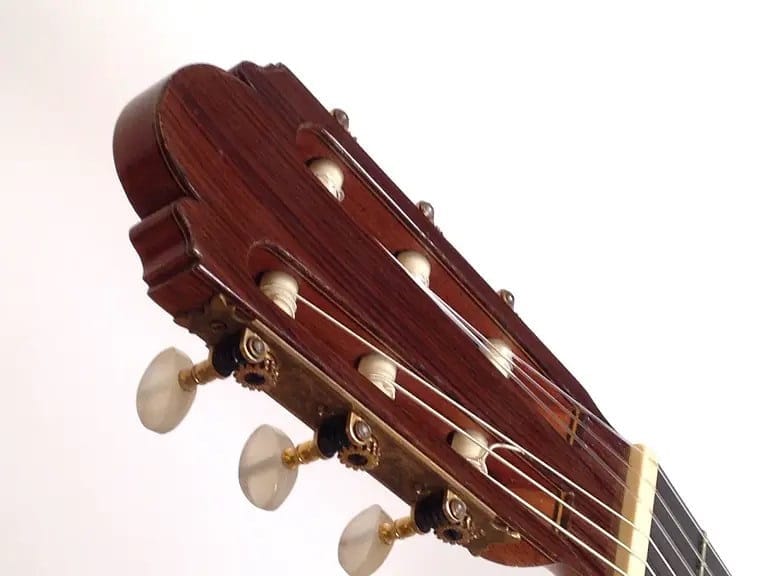
Hauser: Balance and Ergonomics for Effortless Playability
Hauser guitars hold legendary status in the acoustic guitar world, and their headstocks contribute to their esteemed reputation. Hauser headstocks, often in a solid design with string posts, boast impeccable balance and weight distribution.
The carefully crafted design ensures a comfortable playing experience, minimizing neck dive and facilitating unhindered access to higher frets. Hauser’s commitment to precision engineering and ergonomic excellence makes their headstocks a joy to behold.

Kohno: Artistry and Craftsmanship in Curved Slots
Kohno guitars are revered for their exceptional craftsmanship and attention to detail. Their headstocks, frequently featuring elegantly curved slots, exhibit the pinnacle of artistry and craftsmanship that has come from three generations of luthiers.
Kohno’s meticulous wood selection, precise shaping, and flawless execution result in headstocks that are both functional and aesthetically captivating. Kohno headstocks stand as a testament to the harmonious fusion of art and functionality.
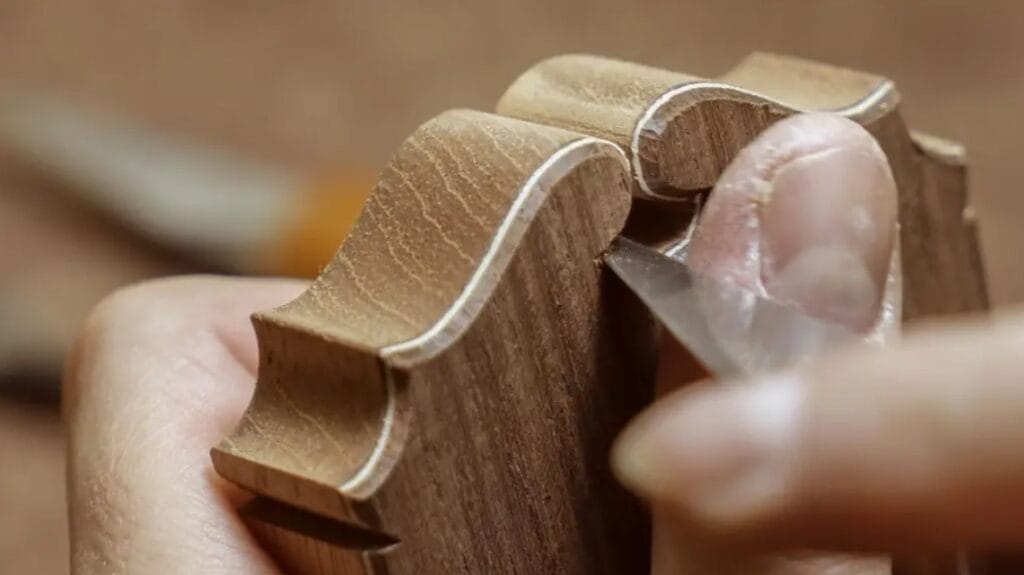
Sobrinos de Domingo Esteso (Conde Hermanos): Ornate Masterpieces in Solid Design
Conde Hermanos, carrying forward the tradition of the esteemed Esteso family, is a Spanish guitar workshop known for its remarkable instruments. Their headstocks, often in a solid design with meticulously crafted string posts, captivate with their exquisite decorative detailing.

Conde Hermanos headstocks feature stunning inlay work and intricate woodwork, transforming them into true works of art. The fusion of traditional craftsmanship and artistic embellishments makes Conde Hermanos headstocks a testament to the beauty of classical guitar design.
Classical Guitar Headstock Maintenance
The headstock of a classical guitar is a crucial component that requires proper care and maintenance to ensure its longevity and optimal performance. By following some essential steps and conducting regular inspections, you can keep your headstock in excellent condition. Let’s explore the key aspects of classical guitar headstock maintenance and the tools necessary for effective care and inspection.
Cleaning and Protection:
To keep your headstock clean, wipe it gently with a soft, lint-free cloth after each playing session. This helps remove dust, fingerprints, and any residue that may accumulate over time. Avoid using harsh chemicals or solvents, as they can damage the finish or the materials of the headstock.
For protection against scratches and minor dings, consider using a headstock cover or a padded guitar case when storing or transporting your instrument.
String Maintenance:
Regularly changing your guitar strings not only improves the overall sound but also prevents excess tension and stress on the headstock. When restringing, ensure that the strings are properly wound around the tuning pegs to avoid unnecessary strain on the headstock and maintain stable tuning. Be careful not to overtighten the strings, as excessive tension can put undue pressure on the headstock and potentially cause damage.
Do not use steel string on a guitar that is made of nylon string.
Check out the guide to classical guitar tunings here.

Inspection Tools
To check the health of your classical guitar headstock, there are a few specific tools you can use:
Visual Inspection:
Start by visually examining the headstock for any visible cracks, dents, or signs of wear. Look closely at the joints between the headstock and the neck to ensure there are no gaps or separations.
Magnifying Glass:
A magnifying glass can help detect fine cracks or imperfections that may not be easily visible to the naked eye. Inspect the entire surface of the headstock, paying attention to vulnerable areas such as the string posts or the area where the nut is seated.
Ruler or Straightedge:
A ruler or straightedge can be used to check the alignment of the headstock with the neck. Place the ruler along the neck length, extending over the headstock. Ensure that the headstock is parallel to the neck and that there are no significant twists or misalignments.
Feeler Gauge:
A feeler gauge can be utilized to measure the gap between the strings and the nut slots. Proper nut slot height is crucial for proper string action and tone. If the slots are too high or too low, it may affect the playability and intonation of the guitar.
Professional Maintenance:
You can keep your classical guitar in good shape with periodic inspections and minor adjustments, but professional luthier service is recommended. A luthier possesses the expertise to address any structural issues, perform fretwork, adjust the nut and saddle heights, and ensure the overall optimal performance and playability of the instrument. They can also detect any potential headstock-related problems that may not be apparent to an untrained eye.
Check out classical guitar accessories here.
Why are classical guitar headstocks different?
Classical guitars were developed before electric and steel-string acoustic guitars, and they were traditionally made by hand by individual luthiers. This means that there is a greater tradition of variation in the design of classical guitar headstocks. Classical guitar headstocks are also generally wider than other types of guitar headstocks, which helps to distribute the tension of the strings more evenly and improve the stability of the neck.
Why do classical guitars have slotted headstock?
Classical guitars have slotted headstocks primarily for traditional reasons, as they use wooden tuning pegs and string tying, which is different from the mechanical tuning machines on other types of guitars. This design also reduces the string angle over the nut and maintains the classical guitar’s classic appearance.
How to string a classical guitar headstock?
To string a classical guitar with a slotted headstock, you typically follow these steps:
- Insert the end of the string through the corresponding hole in the tuning peg.
- Wind the string around the peg, ensuring it winds downward toward the headstock.
- Cut off any excess string.
Repeat these steps for each string, starting with the thickest (lowest-pitched) string and ending with the thinnest (highest-pitched) string. For detailed information about how to string a classical guitar headstock, check out here.
FAQs
In general, classical guitar heads are not interchangeable. Each headstock is designed and built specifically for a particular guitar model or brand. The dimensions, shape, and attachment method can vary between guitars, making it difficult to interchange headstocks without extensive modifications.
Repairing a cracked headstock is a complex task that requires the expertise of a skilled luthier. The repair process involves assessing the severity of the crack, reinforcing the damaged area, and ensuring proper alignment and structural integrity. It is crucial to consult a professional to handle headstock repairs to avoid further damage to the instrument.
If the tuning keys on your classical guitar headstock become loose or slip, it is essential to address the issue promptly. Loose tuning keys can affect the stability of the strings and impact tuning accuracy. Consult a professional luthier who can assess the problem and either tighten the pegs or recommend appropriate solutions, such as replacing worn or damaged components.
- Budget Classical Guitars Under $700 - February 15, 2025
- How To Set Up A 12-String Guitar Perfectly - September 8, 2023
- Vibrato Techniques: A Comprehensive Guide - September 6, 2023







